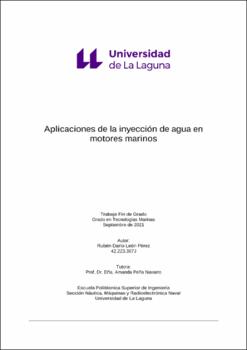Aplicaciones de la inyección de agua en motores marinos
Author
León Pérez, Rubén DaríoDate
2021Abstract
El presente trabajo está fundamentado en las propiedades fisicoquímicas y la capacidad refrigerante del agua pulverizada para reducir las emisiones provocadas por la combustión entre el combustible y el comburente en el interior del motor, además del posible aumento
de rendimiento y potencia posterior. Es una propuesta bastante interesante para aquellos buques que necesitan reducir sus emisiones ya que puede evitar realizar obras de gran envergadura, como por ejemplo la instalación de torres de lavado o ‘Scrubbers’.
Estos son elementos muy voluminosos, que se instalan por lo general en las chimeneas de los buques, colocándose en una sección de los escapes de los motores principales y
requieren una instalación de tuberías de agua, válvulas y la adaptación o una nueva instalación de bombas que puedan suministrar el agua que la Scrubber necesita para lavar los gases
de escape antes de expulsarlos a la atmósfera. Para el contexto de este documento se han
visualizado diferentes trabajos de investigadores internacionales con certificado Creative
Commons, y páginas webs de fabricantes de motores marinos como ‘Wärtsilä’, comparando
y mostrando gráficas o conceptos que aparecen en estos trabajos a modo de argumentación.
Por último, las conclusiones más importantes son que realmente la inyección de agua
en las cámaras de combustión de los motores sí que ayuda a reducir los valores NOx, entre
un 60% y 80%, por ejemplo, pero donde mejores resultados se obtienen es en los motores
rápidos, ya que son capaces de sobrellevar muy bien la reducción de temperatura provocada
por el agua al ser inyectada en las cámaras de combustión debido a sus altas revoluciones
de trabajo. The present work is based on the physicochemical properties and the cooling capacity
of the sprayed water to reduce the emissions caused by the combustion between the fuel and
the oxidizer inside the engine, in addition to the possible increase in performance and subsequent power. It is a very interesting proposal for those ships that need to reduce their emissions
and that can avoid carrying out large-scale works, such as the installation of washing towers
or 'Scrubbers'.
These are very bulky elements, which are usually installed in the chimneys of ships,
being placed in a section of the main engine exhausts and require an installation of water
pipes, valves and adaptation or a new installation of pumps that They can supply the water
that the Scrubber needs to wash the exhaust gases before expelling them to the atmosphere.
For the context of this document, different works by international researchers with Creative
Commons certificate, and web pages of marine engine manufacturers such as ‘Wärtsilä’, have
been viewed, comparing and showing graphics or concepts that appear in these works by way
of argumentation.
Finally, the most important conclusions are that actually the injection of water in the
combustion chambers of the engines does help to reduce the NOx values, between 60% and
80%, for example, but where the best results are obtained is in fast engines, as they are able
to cope very well with the reduction in temperature caused by water being injected into the
combustion chambers due to their high operating revolutions.





